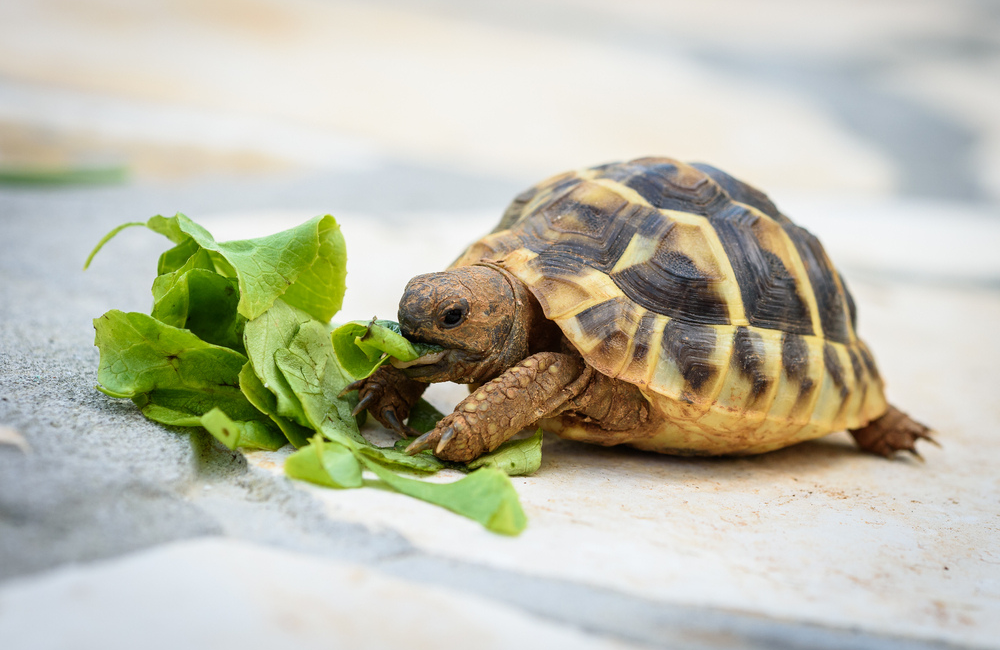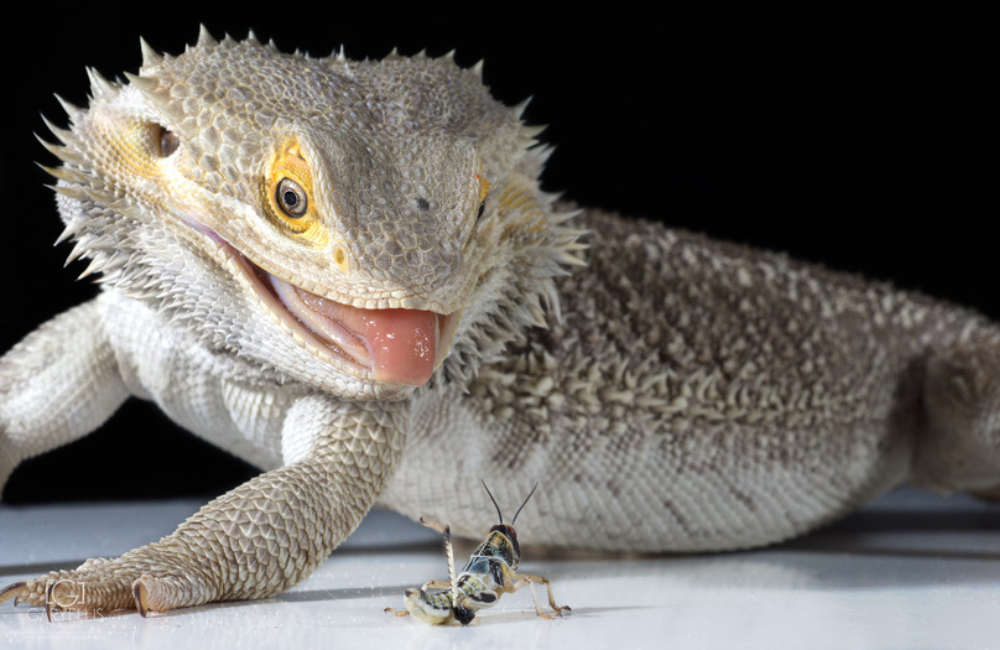What do I feed my reptile to keep it healthy?
When caring for a reptile, you want to do whatever you can to keep your pet happy and healthy. And what you feed your pet reptile plays a big part in that. From prepared foods to fresh, here's a look at what you can feed your pet reptile to keep him healthy.

What type of food does your pet need?
Reptiles fall into four categories when it comes to their food preferences:
- Carnivores: Meat-eaters, like snakes and monitor lizards
- Herbivores: Plant-eaters, like green iguanas, most tortoises, and uromastyx
- Insectivores: Insect-eaters, like chameleons and geckos
- Omnivores: Eat a mix of plants and meat, like bearded dragons, box turtles, and many skinks
Within these categories, each species also has its own unique nutritional needs. Serving species-specific prepared foods (like extruded pellets) with a mix of fresh food is a great choice for most reptiles — except for the few carnivores that prefer whole prey.
In the sections below, you'll find a guide to the types of food you can offer your pet, from prepared foods to whole prey and fresh veggies.
Prepared Foods
Prepared foods are a good way to ensure reptiles of all kinds, from carnivores to omnivores, get the extra nutritional makeup of vitamins and minerals their species needs. If you only feed fresh or live food, keeping track of the vitamins and supplements your pet gets each day can be difficult to ensure he doesn't get sick. Often, prepared food is available in pellets, powdered food, or freeze-dried mixes. Below are four examples of prepared foods your pet might prefer.
1. Pellets
Extruded pellets are a great choice because they typically provide ready-to-eat formulas blended to provide the precise ratio of vitamins, minerals, and proteins your pet needs. Be sure you get the kind designed for your particular species — you don't want to feed a green iguana pellets designed for a tortoise! (And make sure the instructions say the pellets were made to serve as your pet's primary diet, not a supplement or snack.)
Three examples that can be the primary diet or mixed with fresh food include:
- Land Turtle and Tortoise Extruded Food Pellets: Best for land turtles and tortoises that prefer plants, berries, flowers, and some insects.
- Aquatic Turtle Extruded Food Pellets: Designed for aquatic turtles that prefer a diet with fish and crustaceans.
- Bearded Dragon Extruded Food Pellets: Specifically made for your bearded dragon's omnivorous diet, which consists of plants, flowers, and insects. Includes the precise amount of proteins, vitamins, and minerals needed for healthy growth and color.
2. Powdered Mixes
Powdered mixes are a common prepared food choice for fruit-eating geckos, like the crested gecko. Powdered mixes provide an easy way to make sure your pet gets all the vitamins and nutrients he needs. However, even for fruit-eating geckos, you might still want to occasionally supplement with live insects.
The Gecko Gold Powdered Diet is designed for fruit-eating geckos and includes the fruits, protein, vitamins, and minerals that geckos need.
3. Dehydrated Protein
Dehydrated meat products are a great choice for certain insectivores or omnivores because you can deliver all the nutrition your pet needs in a tasty, easy-to-serve product. But read the directions closely; while some can be your pet's whole diet, others are designed just to be a treat. Three options include:
- Reptile Munchies Omnivore: Designed for omnivorous species like bearded dragons, water dragons, box turtles, and tegus. This can be your pet's entire diet or supplemented with fresh food and pellets.
- Reptile Munchies River Shrimp: Nutritious enough to be your pet's entire diet or can be fed with pellets and leafy greens. Great for turtles, salamanders, and axolotls.
- Reptile Munchies Mealworm: Dehydrated mealworms are meant to be treats, not primary food. Great for bearded dragons, leopard geckos, and chameleons.
4. Dehydrated Fruits and Vegetables
Some omnivores and herbivores will love dehydrated fruit or veggie mixes because they deliver all the nutrition your pet needs in a tasty, easy-to-serve product. Three options that can be your pet's sole diet or part of a mix of fresh food and pellets include:
- Reptile Munchies Vegetable Mix: Ideal for herbivores like iguanas, tortoises, and uromastyx.
- Reptile Munchies Vegetable and Fruit Mix: Great for bearded dragons, iguanas, tortoises, and uromastyx.
- Reptile Munchies Fruit Mix: A good choice for iguanas, blue-tongued skinks, tegus, box turtles, and red- and yellow-footed tortoises.
Live or Fresh, Whole Prey
Live or whole, fresh prey adds variety to the insectivore, omnivore, or carnivore diet and can make a great treat for your pet because the food provides mental stimulation that can enrich your pet's day-to-day living.
Insectivores will enjoy insects like brown crickets, grasshoppers, and mealworms. Omnivores also like these insects, although they don't crave them as much as they get older.

Most snakes enjoy whole prey, like rodents or even larger mammals. Many owners feed freshly killed or frozen prey because live prey like rodents might injure their snake.
Some snakes simply won't eat food that isn't moving because it triggers their natural hunting instinct. In that case, you might try dangling a pre-killed rodent with tongs close to your snake's face to entice your pet. Remember: many snakes only need to be fed every seven to 14 days.
Fresh Fruits and Veggies
Herbivores and omnivores love fresh fruits and veggies fed alongside prepared food to ensure optimal nutrition.
Herbivores will especially appreciate eating fresh leafy vegetables because the fresh food is tasty and mentally stimulating. Consider food like collard or mustard greens, kale, beets, romaine lettuce, green peas, dandelions, squashes like pumpkins, and sweet potatoes. They appreciate certain fruits too, like berries, pears, bananas, apples, and peaches. A good rule of thumb is 70-20-10: 70% leafy greens, 20% other veggies (like carrot or zucchini), and 10% non-citrus fruit.
They can occasionally have broccoli, kale, or cauliflower. If fed more frequently, these vegetables prevent your pet reptile from properly absorbing calcium and may lead to thyroid issues.
The same types of leafy greens can be good for omnivores too. In fact, many would love to get fresh fruits and veggies daily once they're adults.
The Right Diet Can Keep Your Pet Healthy
Feeding your pet the right diet is important to keep him healthy. This starts by knowing if your reptile pet is a carnivore, herbivore, omnivore, or insectivore. From there, determine the species' specific needs, whether they enjoy live prey or the occasional fresh veggie treat to supplement a commercially prepared diet. If you have any questions, check with your veterinarian.
